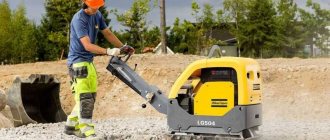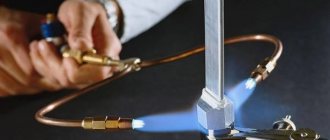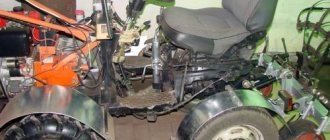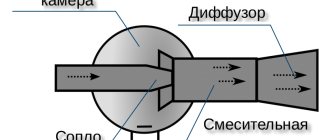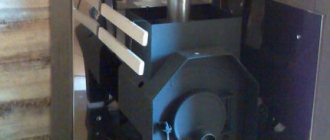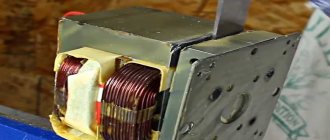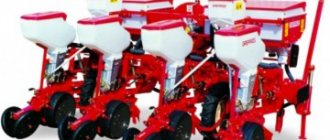During the production process, scale forms on castings. Metal parts rust when exposed to the environment. To get rid of contaminants, the workpieces are sent for sandblasting.
It can be done industrially, or it can be done at home or in a garage, because more than once there has been a need to clean all sorts of parts from rust.
Kinds
There are 2 types of units that are used for sandblasting metal products.
Inhabited
Habitable vehicles are structures that are designed to clean large workpieces. There is a movable nozzle inside the device. Human participation is required to control technological processes. The operator uses the capabilities of the device for high-quality processing of workpieces.
Uninhabited
Uninhabited vehicles are more compact in size. The equipment consists of walls, a sight glass and a hole for the sandblasting nozzle. Moreover, the operator is outside during processing. The height of small-sized boxes does not exceed human height.
The disadvantages of manned vehicles include an increased risk of human injury. Therefore, equipment owners pay great attention to safety precautions. To prevent small dust particles from entering the lungs, it is necessary to install a ventilation system. The specialist must wear protective gloves and goggles.
Manufacturers produce 3 types of uninhabited cameras:
- There are ejector models that are capable of processing small workpieces.
- To clean thick plaque, pressure structures are used.
- The safest option is to use automatic devices that are controlled using a panel.
Accessories
In addition to the compressor and nozzle, before making a sandblaster, you need to prepare other necessary materials and tools. Most of them are available in every home workshop, but some will have to be purchased at a hardware or hardware store.
A used gas cylinder made of high-strength metal is suitable as a container for abrasive. The tightness of the cylinder also allows it to be used for storing and supplying sand. To make it more convenient to pour sand, you can weld a small piece of pipe to the top of the cylinder, which will serve as a “neck”. Instead of a cylinder, you can use any barrels or containers.
If buying a ready-made compressor causes financial difficulties, you can build it yourself. The basis will be a compressor head from a MAZ or ZIL pneumatic drive, the power of which is sufficient to create a good sandblast. The head must be equipped with a receiver, although you can work without it - then air will be taken in constantly.
Depending on the complexity of the finished structure, other components may be required:
- Ball Valves;
- rubber hose with reinforced inserts with a diameter of 14 mm or more;
- air hose with a diameter of up to 10 mm;
- fittings for attaching hoses or collet clamps;
- transition coupling;
- FUM tape for sealing and connecting elements;
- empty 0.5 liter plastic bottle;
- glue gun and hot glue;
- grinding machine or file, sandpaper with a block;
- drill with drills;
- sharp knife;
- Bulgarian;
- pliers.
Design and principle of operation
When choosing a sandblasting chamber, you need to pay attention not only to cost. The equipment must ensure high-quality cleaning of scale and rust from the surface of parts. The capabilities of the units depend on several technical characteristics:
- diameter of the nozzle and connecting hoses;
- compressor power;
- abrasive material feed rate;
- control system;
- camera dimensions.
During the processing process, metal products go through the following stages:
- First, the part is secured in the chamber using clamps.
- After this, special containers are filled with abrasive material.
- The operator starts the compressor, which allows you to regulate the air flow rate. For this purpose, a system of valves and shut-off valves is used. During the processing process, air is mixed with abrasive particles. The resulting mixture comes out through the nozzle.
Thanks to abrasive processing, you can evenly clean the product from plaque, rust and dirt. Before starting the equipment, it is necessary to check the condition of the connecting hoses and clamps.
Selecting the device to buy
To select a quality device, you should pay attention to the following criteria:
- A waste separation system must be present.
- A ventilation unit is welcome.
- There must be a “cyclone” that collects the smallest fractions of abrasive.
- The better the material from which the facing walls are made, the better the cleaning.
- A good device should have an automatic pipeline cleaning unit.
- Additional features are welcome, these include a rail track, cart, etc.
- The basic camera kit should include special gloves, a protective helmet, a mask, overalls and shoes.
Sandblasting is one of the best achievements of mankind. This method allows you not only to use the device to prepare for further work, but also to use it for the purpose of decorating, cleaning and extending the service life of any surface.
Drawings with dimensions
When assembling the sandblasting chamber, you must adhere to the dimensions indicated in the drawing.
Making a simple sandblasting machine from a plastic bottle and an air gun
Here are step-by-step instructions for making a homemade sandblasting machine that works on the principle of an ejector (spray gun).
Step 1. You need to buy or borrow an air gun rated for pressure up to 4 MPa, a plastic 0.5- or 1-liter bottle, a fitting, hoses and drills. We will mention other materials and tools as they are used at the appropriate step.
Step 2. We twist the cork from the bottle, and cut the remaining band on the neck with a carpenter’s knife and remove it. Screw the lid tightly into place.
Step 3. Using an electric drill and a 5 mm drill, drill the neck of the bottle in diameter on both sides, right under the cap itself.
Step 4. Carefully insert the tube from the kit to the air gun into the drilled holes. We determine on it the place where the bottle with sand will be located. It should be closer to the air gun. This will ensure greater structural reliability, better balancing and ease of operation.
Step 5. We take the tube out of the holes in the bottle and use a marker to mark on the tube the place where an oblong hole will be cut to allow sand to come out of the container.
Step 6. Using a metal file, we make an oblong, narrow hole on the tube, carefully cleaning its edges.
Step 7. We return the tube to its place again, and the hole cut with a file should be directed downwards, and the bottle will be located vertically above it.
Step 8. Fill the places where the tube enters and exits the bottle with suitable glue, firstly, to ensure the strength of the connection, and secondly, for sealing, so that during operation of the sandblasting device the air supplied by the compressor does not escape outside.
After waiting for the glue to completely harden, you can begin testing the sandblasting machine by first pouring dry sand with a particle size of no more than 0.5 mm into a bottle, and connecting the gun with a hose to a compressor that is able to provide a pressure of 4 MPa (bar).
Step 9. We direct the gun tube at the dirt on the garden path, adjusting the air pressure, and therefore the sand flow, using the handle on the tool. The cleaning efficiency is obvious.
Step 10. Let's try to remove rust from pliers that have been lying somewhere for a long time, exposed to water or humid air. By directing a stream of air mixed with sand at the rusty spots of the tool, we achieve its complete cleaning. After this treatment, the metal surface acquires a noble matte shade.
For information: a household air compressor is used as a source of compressed air, on the control panel of which there is an air flow adjustment knob, a flow meter, fittings for connecting hoses and a pressure gauge indicating the pressure in the system. As a cleaning agent, along with fine sand, you can use finely crushed walnut shells.
How to make homemade sandblasting with your own hands
To assemble a sandblasting chamber yourself, you need to know its design and operating principle.
Work zone
The closed part of the chamber in which the part is processed is called the working area. There is a mesh surface on its floor, which is necessary for the timely removal of used abrasives. Waste falls through the bottom of the chamber. A prerequisite for the normal functioning of the unit is the presence of an inspection window. Lamps installed in the chamber must be protected from abrasives and dust.
Cone bottom
The main task of the cone bottom is to remove spent abrasive.
Hood
Without a hood, it is impossible to completely get rid of dust. During the processing process, abrasive particles hit the treated surfaces at high speed. In this case, the material is destroyed and turns into dust. It is advisable to organize automatic abrasive recovery. This technology allows the material to be reused.
Sandblasting machine
There are 2 types of sandblasting machines:
- ejector;
- pressure
The devices differ in operating principles. In ejector units, compressed air is supplied directly to the sandblasting gun. In this case, the abrasive flows by gravity from the tank through a separate hose. The abrasive particles are not accelerated as much as in pressure units. The duration of ejector sandblasting treatment is 2–4 hours. For quick cleaning of products, pressure-type devices are used. Thanks to this scheme, it is possible to increase the particle emission speed. This allows for more intensive surface cleaning
General building
The common housing contains attachments, electrics and a pneumatic control device. When assembling yourself, you must take into account that the holes should not be too narrow. The optimal diameter is 16-20 mm. There is an air damper at the top of the equipment.
Lighting
To prevent the cell from being too dark, it is necessary to properly organize the lighting. Plastic covers are used to protect the lamps from dust. With their help, you can prevent damage to electrical contacts. As an additional measure of protection, a fine-mesh mesh is used. It is placed on top of the casing. The design increases the service life of the viewing window.
How to choose the right type of sandblasting chamber design?
The last thing that will help you decide which camera you need is understanding what will be processed in your booth. If you plan to clean car rims, you only need a pressure chamber, otherwise cleaning will be very, very slow. If you plan to occasionally carry out household cleaning of parts, an ejector chamber is quite suitable for you. If you have a large volume of work, you will need a pressure chamber, also with automatic abrasive recovery.
Safety precautions
When the open type unit operates, active spraying of abrasive crumbs occurs. A special suit is used to protect the operator. During operation of the equipment, a high level of noise occurs. The owner of the unit must take care of soundproofing the room.
Large amounts of dust pose a danger to humans. A filter is used to clean the air in a timely manner. The sandblasting chamber must be connected to the ventilation system. Purified air is supplied through a special hose directly to the operator’s helmet.
How to make a portable sandblaster yourself - step by step diagram
This device may not boast large dimensions, but it can do the same job as its larger counterpart. True, its scale is a little smaller. To make a lightweight model you need to find:
- reinforced hose;
- ceramic nozzle (modified spark plug);
- compressor;
- plastic bottle (1.5 or 2 l);
- spray gun valve;
- plumbing tee;
- ball valve
In addition to a set of wrenches, in this case you will need a drilling and lathe machine to turn the faucet. Based on the diagram, a nozzle is assembled from a mixer, tee, ball valve, bottle and nozzle.
- The gun body is turned on a lathe to fit the size of the nozzle.
- It is connected to a tee mixer, one fitting is connected to the compressor, and a nozzle is mounted on the second. The third is connected to a container containing abrasive.
- They make a channel between the gun and the compressor. The tap is mounted between the bottle and the tee. The latter is connected to the handle of the spray gun.
- The top of the bottle is cut off.
This portable device is not durable, but it can effectively clean surfaces for about half an hour.
A method for making a homemade sandblasting machine from a spray gun
Sandblasting can also be done using a spray gun. For assembly you need to prepare:
- a gun that functions as a mixing valve;
- handle with air supply device;
- a plastic bottle that acts as a tank for abrasive;
- tee;
- ball valve for regulating sand supply.
Using an airbrush instead of a spray gun will allow you to apply abrasive at higher pressure due to the smaller thickness of the outlet channel.
Assembly is performed in the following sequence:
- The gun is bored to increase the diameter of the output nozzle.
- The mixing tee is attached to the gun.
- The supply and circulation hoses are installed and attached.
- The abrasive is released after the trigger is pressed. The volume of a small plastic bottle is enough to clean surfaces for 30 minutes.
